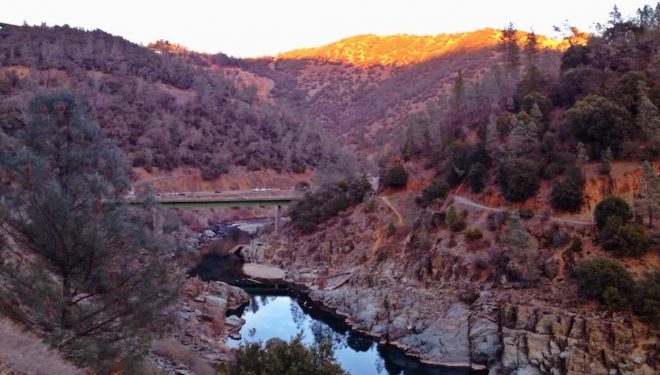
By Geremy Holm and Steve Anderson
In March 2020, the U.S. Geological Survey (USGS) released a study seeking to explain the physical mechanism behind the correlation between temperature increase and reduced streamflow in the Upper Colorado River Basin. Using a new model and satellite-based observations, the study found that melting snowfall caused by atmospheric warming was the driving force behind streamflow reduction in the Colorado River. The study was able to project a streamflow reduction rate of about 5 percent for every degree of temperature increase. Such information may be useful in developing management programs that account for potential reductions in Colorado River streamflow in the future.
Background
Approximately 1,450-miles-long, the Colorado River is one of the principal water sources in the Western United States. The Colorado River drains an expansive watershed that encompasses parts of seven U.S. states and two Mexican states. The river and its tributaries are controlled by an extensive system of dams, reservoirs, and aqueducts, which in most years divert its entire flow for agriculture, irrigation, and domestic water. The Upper Colorado River Basin (Upper Basin) accounts for approximately 90 percent of the water flowing in the river. Water from the Upper Basin is currently used for services provided to approximately 40 million people and supports economic activity in the United States Southwest, estimated at $1.4 trillion each year.
Water in the Upper Basin originates as precipitation and snowmelt in the Rocky and Wasatch Mountains. Due to year-to-year differences in precipitation and snowmelt, the natural water supply of the Upper Basin is highly variable. Since the early 1900s, water demand in the Upper Basin has increased while water supply has, on average, decreased. The Upper Basin is susceptible to long-term drought, demonstrated by the impacts of the ongoing drought that began in 2000. While previous studies have generally established a link between global temperature increase and streamflow reduction in the Upper Basin, with varying estimates of its impact, the USGS’s recent study incorporates more than two-decades worth of satellite imagery and information that other studies have not significantly incorporated.
The USGS Study
The recent study conducted by the U.S. Geological Survey used a new model and updated satellite-based observations to explain the mechanism behind flow reduction and shortages in the Upper Basin. The primary focus of this study was to measure surface net radiation rather than focusing only on temperature measurements to explain flow reduction. Surface albedo, also known as reflectivity, determines the amount of solar radiation that is absorbed by land surface, which can drive the process of evapotranspiration. Evapotranspiration is the sum of evaporation and plant transpiration from the Earth’s land and ocean surface to the atmosphere. This process accounts for the movement of water to the air from sources such as the soil, canopy interception, and waterbodies. As a result, an increase in evapotranspiration increases the movement of water to the air and reduces the amount of water remaining in waterbodies.
The USGS study revealed that the reduction of snow cover largely accounted for the decrease of streamflow in the Upper Basin. Surface albedo is highly sensitive to snow cover, which is an efficient reflector of solar radiation. As temperatures rise, more precipitation falls as rain instead of snow, and what snow does fall melts earlier in the year. The loss of snow exposes the land to increased solar radiation. The absorbed radiative energy is dissipated by further heating of the lower atmosphere and increased evaporative cooling. The increased evaporation consumes water that would otherwise run off into the river, reducing the amount of streamflow. This results in a chain reaction, where the increase in temperature starts a process which ultimately leads to a further increase in temperature.
Due to the reduced snow cover, streamflow in the Upper Basin is decreasing by about 5 percent per degree Fahrenheit as a consequence of atmospheric warming, causing a 20 percent reduction over the past century. There is the possibility that precipitation levels may change as a result of climate change, but this remains highly uncertain. While increased precipitation may partially offset the impacts of atmospheric warming, precipitation decreases would likely exacerbate warming impacts. Until now, the inability to identify a physical mechanism that accounts for the sensitivity of streamflow to atmospheric warming has made the translation of climate-change temperature projections into flow projections highly uncertain. The identification of these physical mechanisms may enable more robust projections of future streamflow, which in turn may allow for more precise planning and management of Upper Basin water resources.
Conclusion and Implications
Because Colorado River water supplies millions of people, businesses, and farms with water, the projected future reduction of Colorado River streamflow due to atmospheric warming poses a significant concern. The Upper Basin continues to experience streamflow reductions that may increase over time. However, the identification of the physical mechanisms behind streamflow reduction, as well as the corresponding reduction rate of 5 percent per degree Fahrenheit, may help future planning by water agencies, industry, and agricultural interests in the future. The U.S. Geological Survey study is available online at: Colorado River Flow Dwindles as Warming-Driven Loss of Reflective Snow Energizes Evaporation, available at https://www.usgs.gov/center-news/colorado-river-flow-dwindles-warming-driven-loss-reflective-snow-energizes-evaporation?qt-news_science_products=1#qt-news_science_products



